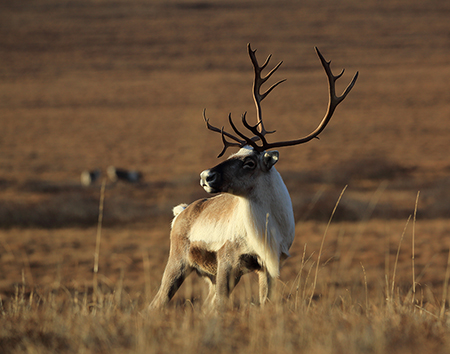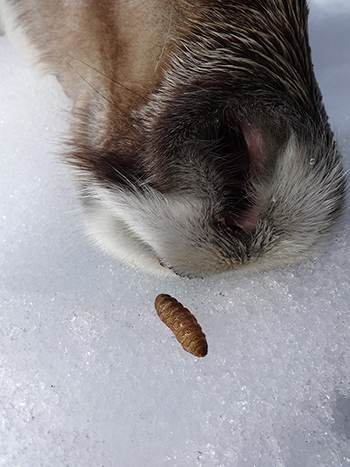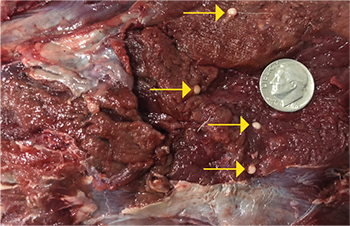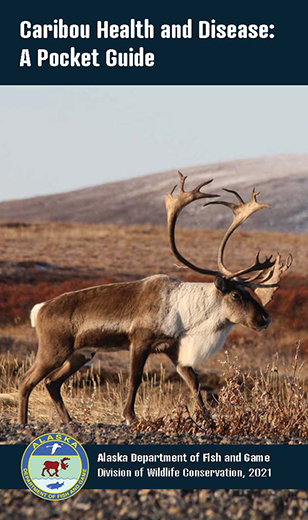Alaska Fish & Wildlife News
September 2021
Caribou Health and Disease: A Pocket Guide

Every August and September, staff at the front desk of every Alaska Department of Fish and Game office get phone calls from hunters, alarmed because “there is something in my game meat!” The phone call generally unfolds as a series of questions: “What is it? Can I/should I still eat the meat? Is it safe? Is there anything I should do to avoid or prevent eating something unsafe? Is this safe for my family, pets? Should I bring a sample in for diagnosis? Does ADF&G want samples? Of what? Help?!”
The state Wildlife Health Veterinarian focused on wildlife diseases and parasites is Dr. Kimberlee Beckmen. Along with a few biologists that help run the ADF&G Wildlife Health Program, she helps front desk personnel field these questions for the entire state during hunting season. One of the main priorities for Dr. Beckmen is to get as much up-to-date information about wildlife diseases and parasites as possible to hunters and wildlife observers. One of the strategies is to create and distribute wildlife disease field guides to provide members of the public with a simple tool to help identify conditions encountered during wild game harvest. The guides also advise hunters about safely handling and consuming meat, and information on when/how to reach out to ADF&G for more information if needed.
Caribou are among the most abundant and harvested wildlife species in Alaska. Before the start of this caribou season ADF&G released a new guide on caribou health, which includes common parasites and diseases, meat safety information for humans and pets, and specific samples that are required or requested by the Wildlife Health program. “Caribou Health: A Pocket Guide” is also complementary to a similar moose health guide published last year.

Most of the calls ADF&G receives about caribou parasites or disease are for common and relatively harmless conditions. Hunters often find abscesses and tapeworm cysts during meat processing. Abscesses are pockets of white blood cells (pus) working to contain an infection. Pus from abscesses can contaminate meat, but abscesses/pus can be carefully removed, and any uncontaminated meat is safe for consumption. Tapeworm cysts are created by tapeworm larvae, which caribou usually consume from eating contaminated vegetation. Cysts can form from three different common tapeworms specific to internal locations–muscle/heart, lungs, or liver. All are common, and none directly infect humans, though they can potentially infect dogs if fed raw meat. Muscle/heart tapeworms and liver tapeworms are not transmissible to humans at all; lung tapeworms can theoretically infect humans exposed to scat from dogs that have been infected, but it is easily preventable. The good news is that tapeworms can be easily killed in meat or organs by cooking thoroughly OR a hard freeze*.
Caribou are also susceptible to a variety of insects, including parasitic flies that require a host to complete their life cycle. While hunting or in the field, hunters may notice nasal bot flies or warble flies, both of which infest caribou by laying their eggs on caribou, that then develop into larvae in the nose/back of the throat (nasal bots) or under the skin (warbles). Although gross (yes, even the biologists think so!), neither harm caribou meat quality nor infect humans, but some caribou with a lot of warbles may be on the thin side.
While wildlife parasites and diseases may be a bit off putting as a topic, hunters should consider wild game meat, even with a few cysts or an abscess, to be a very healthy choice to fill their freezers. It is rare that an animal is completely riddled with parasites and diseases unless it has an underlying health condition. Dr. Beckmen has examined hundreds of deceased moose and caribou over the 30 years of her career studying wildlife disease and emphasizes that she has not ever come across a moose or caribou yet that was completely parasite and disease free – both are normal components of the internal flora and fauna of wild animals. She is also a hunter, and regularly consumes wild game meat.

Hunters and wildlife enthusiasts are an important resource in monitoring wildlife health across the state. The late summer and fall months (August, September, and October) are when hunters and wildlife observers are usually out on the landscape in the biggest numbers. Reports from the public are one of the best sources of information about unusual wildlife sightings, especially across the incredibly vast landscape of the state of Alaska.
ADF&G staff have streamlined the reporting process to try and make it simple and accessible for anyone to report conditions of concern that they observe in the field or during meat processing. Click this link to find simple reporting procedures, a sample submission form, wildlife health contact information, and more about parasites and diseases: wildlifediseasereporting.adfg.alaska.gov. Detailed instructions for when and how to report observations or submit samples can also be found in the guide, either online (https://www.adfg.alaska.gov/index.cfm?adfg=disease.main) or free in your local ADF&G office. (A PDF version of the booklet is also available for download at the link.)

If you have a question about a caribou health condition, we encourage you to consult the guide first to make an initial assessment. If possible, check to see if samples are requested (or required) for the suspected condition before bringing it in to ADF&G, and please make sure you fill out a form for any sample you submit, which provides critical information. If you have a question about a condition after checking the guide, email the Wildlife Health program – often Dr. Beckmen can diagnose “that thing” in your meat just by looking at a few photos.
The caribou health guide (like the moose guide) is aimed to prepare hunters to recognize common caribou health conditions they may come across, assess meat safety, and outline best practices during meat handling and processing. Dr. Beckmen often reiterates that a few things are always recommended while processing caribou (or other wildlife) – always wear gloves when butchering, cook meat thoroughly, and get in touch with ADF&G if you have any concerns.
*Tapeworms are killed by freezing, but most other pathogens are not. In general, cook meat thoroughly to kill bacteria, viruses, and other parasites.
Jen Curl works for ADF&G in Fairbanks as part of the Wildlife Education and Outreach program within the Division of Wildlife Conservation.
Subscribe to be notified about new issues
Receive a monthly notice about new issues and articles.
